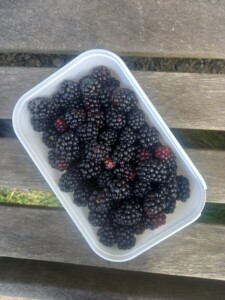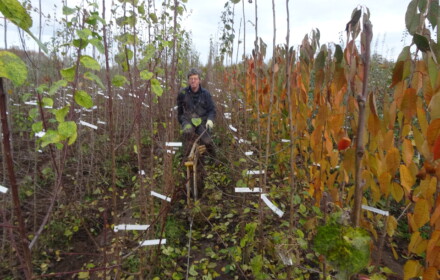I think of growing fruit, whether it be trees, bushes or canes, is good value. Plant in a suitable situation, nuture it and your plants will repay you many times over. One species this really does apply to in late summer is the Blackberry. A few hours collecting wild blackberries in hedgerows can be enjoyable occasionally. The cultivated blackberry is related to its thorny parent but is now far removed with large juicy even sized berries carried on often thornless canes. They are are pleasure to pick!

The nature of the Blackberry is to spread and to take over! Even the tips of the long shoots, if not trained, will droop to the ground and will root readily. The cultivated blackberry like its parent can be similarly rampant. But with this in mind, with management the rewards of blackberry growing are great.
When considering Blackberry growing space is required. Allow 4m (12’+) for each plant. If not enough space is given it will out grow its space and ramble into and over neighbouring plants. To manage the growth a post and wire setup will be required. This is not required in the first summer after planting – they will be establishing but do get it installed before the second years growth starts allowing for wires up to 1.8m high.
Blackberries are Floricanes – they flower and fruit on the previous years growth. So once established you will be managing two years of growth during the summer – the current seasons growth and the previous seasons growth which will be carrying the fruit. This is not too onerous, you just need to tie in the new growth occasionally ensuring light to the fruiting second year cane.

There are a few ways of growing Blackberries and managing the canes
As a fan – where the new canes are radiated out leaving space in the centre to tie in the following years new canes. The following year the fanned out canes will fruit. After fruiting cut out the canes and fan out the new canes in the centre to leave space for next years new canes.
Alternate – the new canes are trained one way from the point where the Blackberry is planted. These canes will fruit the following year following year with new canes emerging. They can be trained in the opposite direction. The process is repeated in following years training new canes to fill the area where the previous years canes where removed
Informal – this is the system we use where new and second fruiting canes are trained amongst each other. They need to be tied spreading them out for good air circulation and good light to the second year fruiting canes.

Once they start fruiting blackberries should be very productive for at least 10-15 years maybe longer. Later in life their yields will start to decrease. Their life is much longer than raspberries and the new canes only arise from one place! With this in mind I would recommend good stout treated support posts to start with ideally with some extra protection against rotting at soil level and just below where posts often rot.
If you have space they are great plants to grow and relatively trouble free. There are many different varieties available and they have different fruiting times so if you have space for more than one plant you can have a spread of fruiting from July into October
From what I can see most varieties are grown as softwood cuttings in small pots which lends itself to eventual sales in containers. We offer two varieties – early fruiting Waldo and later ripening Merton Thornless. We have grown both in our Fruit garden and both have been excellent this year. Waldo was picked from mid July until mid August when Merton Thornless started to ripen.

Once established and you would like another blackberry(ies) a tip, pardon the pun, is to to layer a growing tip into a small filled plant pot buried in the soil at the end of the summer. Sever late winter and you should have a pot full of roots! This is how our Early Worcester Loganberries have been produced and what happens naturally with blackberries growing wild.
After fruiting it is sensible to remove the old fruited canes to prevent any possible disease spread and give more light and air to this years canes (that will carry fruit next year). The photos below show the difference – before and after removal of fruited canes.











